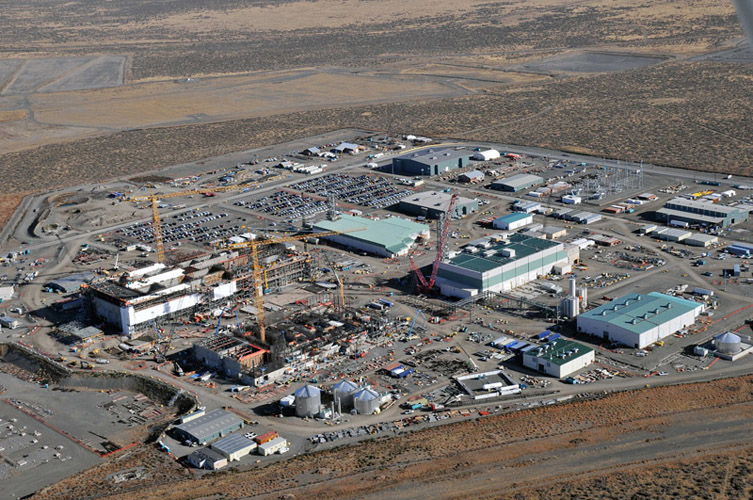A rendering of ISP’s proposed interim storage facility in West Texas. (Image: ISP)
A federal appeals court rejected a lawsuit brought by environmental groups challenging the Nuclear Regulatory Commission’s licensing of a consolidated interim storage facility (CISF) for spent nuclear fuel in Andrews County, Texas. The U.S. Court of Appeals for the D.C. Circuit found that the NRC reasonably applied its hearing regulations when approving Interim Storage Partners’ (ISP) license for the facility.
Hanford’s Waste Treatment and Immobilization Plant. (Photo: DOE)
The Department of Energy is asking for feedback on a new report analyzing potential options for preparing high-level radioactive waste for vitrification at the department’s Hanford Site near Richland, Wash. Vitrification is the process of treating radioactive waste by immobilizing it in glass.
The report, Waste Treatment and Immobilization Plant High-Level Waste Treatment: Analysis of Alternatives, was commissioned in response to a 2018 determination by the U.S. Army Corps of Engineers that it was unlikely the DOE would meet its mandated deadlines for treating Hanford’s tank waste.
The first shipment of downblended surplus plutonium from SRS’s K Area leaves SRS. (Photo: DOE)
The Department of Energy’s National Nuclear Security Administration and Office of Environmental Management have completed the first shipment of downblended surplus plutonium transuranic (TRU) material from the K Area at the Savannah River Site in South Carolina to the Waste Isolation Pilot Plant in New Mexico.
The Integrated Waste Treatment Unit at the Idaho National Laboratory Site. (Photo: DOE)
The Department of Energy’s Office of Environmental Management (EM) said that the Integrated Waste Treatment Unit (IWTU), the radioactive liquid waste treatment facility at the Idaho National Laboratory Site, began its final heat-up in December prior to initiating radiological operations, planned for early this year.
IWTU crews were to follow a prescribed incremental process as the facility transitions from simulant to sodium-bearing waste (SBW), according to EM.
A radiological control technician checks radiation readings on waste containers at WIPP. (Photo: WIPP)
The New Mexico Environment Department (NMED) is adding several conditions to the operating permit for the Department of Energy’s Waste Isolation Pilot Plant (WIPP) near Carlsbad, N.M. The permit changes, which would prioritize the disposal of transuranic (TRU) waste generated in the state and limit the repository’s capacity, are contained in a fact sheet the NMED.
A tanker holding 6200 gallons of leachate unloads at a backup load-in station at the Hanford Site’s ETF. (Photo: DOE)
Construction of a backup load-in station has been completed at the Hanford Site’s Effluent Treatment Facility (ETF) in Washington state.
“We broke ground on the backup facility about a year ago,” said Rob Wood, project manager for Washington River Protection Solutions, the Department of Energy’s tank operations contractor at the site. “I am proud of the team for completing this portion of the load-in expansion project and doing it safely. In phase two, expansion of the main load-in station will prepare us for 24/7 operations on the Hanford Site.”
Watch a time-lapse video of the backup load-in station construction here.
Workers walk down a passageway in Panel 8 at the Waste Isolation Pilot Plant in November. (Photo: DOE)
Employees have begun emplacing defense-related transuranic (TRU) waste in Panel 8 of the Waste Isolation Pilot Plant (WIPP) in New Mexico, the Department of Energy’s Office of Environmental Management (EM) announced in November. TRU waste is permanently disposed of at WIPP in rooms mined in a Permian salt bed 2,150 feet below the surface.














